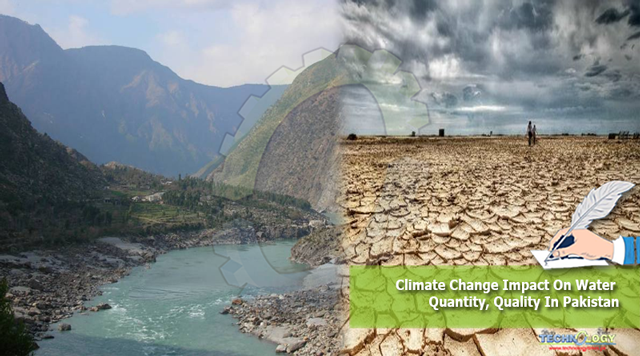After seeing the current situation of sudden climate change pattern there should be a specific connection of climate and water resources ministry.

By : Engr. Asif Ali
Instead of rare jeremiad, let us the need to act now!
Climate mainly depends upon two factors. First temperature and other rainfall events. Climate in hot summer effects the quantity of water in Sea, rivers , lakes and surface water bodies and also had adverse effect on groundwater that will be explained later. In Pakistan Water exist in three form such as ground water, surface water and rainfall water that occurs due to hydrological phenomenon. Water play an important role in hydrological cycle phenomenon and in economic growth of the country. The water need for irrigation purpose in Pakistan is dependent upon rainfall, surface water and groundwater. All three type of water changes its shapes due to different climate patterns. Too much temperature also affects the water availability through transpiration and evaporation losses. And low temperature in northern area of Pakistan cause glaciers and land sliding. Too much rainfall causes urban flooding due to scarcity of water resources and their management. So now I describe climate change effects in Pakistan with respect to temperature and rainfall and its effect on Pakistan water availability. Groundwater and surface water bodies are dependent upon rainfall and temperature to control groundwater level in both resources. Water resources management, designing and operation depend upon the groundwater availability, rainfall (Climate changes) and surface water bodies flow rate and mainly dependent upon climate of that area. When climate change then different disaster problems occurred like in Karachi, Pakistan.
After seeing the current situation of sudden climate changing pattern there should be a specific connection of climate and water resources ministry. Annual tasks (construction of new mini dams to control urban flooding, temperature scenario of the region, surface waterbodies capacity, rainfall events with different intensities) should be reported by this ministry all over the Pakistan and output/control measures against given task against different disaster events with record of climate at different Spatio-temporal scale such as daily, monthly, weekly, seasonally and yearly. if rainfall pattern is decreasing, water saving techniques (sprinkler, artificial raining and drip irrigation) should be applied to control groundwater quantity and its depth. Some new amendments should be made to extract water through tubewells and their installation distance and maintenance, to control groundwater quality and quantity. If climate change major resources construction like Mangla and Tarbella reservoirs is difficult due to high cost then mini dams like Simly dam Islamabad should be constructed to cover rainfall watershed area.
During maximum rainfall, It may be due to the high precipitation which may leach down maximum salts, high canal flow which may also dissolve salts through seepage and high temperature which may cause high rate of reaction in soil that effects high salts accumulation in groundwater with time. According to world mapping scenario, in 2030 Pakistan will at critical level of water deficiency (less than 1000 cubic metres per person), due to increase in population. But there are no authentic resources to control flooding and saving water that is falling into Arabian Sea with 32 MAF (Million Acre Feet). About 22 MAF is wasting according to international policy of water dropping into sea. Due to increase of temperature, water is wasting in hot seasons by evaporation, transpiration, perculation and during seepage losses from canals. The name Urban flooding is given to Karachi and Lahore due to unavailability of resources and bungling polices of policy makers, Pakistan bureaucracy and politics. So permanent solution to tackle the climate changes will be resources management and their constructions. Climate is also affecting groundwater quality and quantity as well as level and caused urban flooding due to lack of water resources. Now a days, climate conditions are at its peak position, but water is wasting.
It was concluded that the Essay investigates the effect of meterological parameter (Rainfall and Temperature) and canal discharge on groundwater quality and water resources. S0, maximum precipitation and discharge will be obviously observed in post-monsoon season and the same residual effect can cause the high sodium (Na) ratios in groundwater chemistry during monsoon due to the forerunning season. High precipitation leaches down the maximum salts but high canal discharge dissolve the salts through high temperature and seepage which may cause high rate of reaction in soil that effects salts accumulation in groundwater with time. Thus, water that leaves the soil to the underlying groundwater is enriched with salts. But more plants and trees should grow to maintain temperature and pollution strategy that is affecting global scenario.The results demonstrate absolute dissolution mechanisms involved in groundwater chemistry of the area under study.
Accordingly, following recommendations are summarized:
- Rainwater harvesting, auriferous storages and artificially recharge techniques should be chosen accordingly, to protect from urban flooding and maintaining groundwater quality.
- Steps should be taken to control emission of hazardous substance from different resources (HFCs, smoke and waste from industries) to control temperature and global warming effects.
- The policy maker should make new amendments about the extraction rate of groundwater and installation of tubewells where climate more varying.
- Researcher should analyze the previous data of climate to control the disaster events, like to manage too much temperature or rainfall events.
- Mini dam should be constructed to manage high rainfall events as well as to manage water quantity in hot dry seasons.
- In Pakistan, all season exist with different climate pattern, mostly in last few years more climate was changed. Therefore, different tasks were given by the International community to Pakistan to manage its climate that were almost achieved about 10 year ago.
Review:
It is confirmed that this article is not submitted to any other publication.
Name: Engr. Asif Ali
Engineer
Department of Agricultural Engineering BZU-Multans
